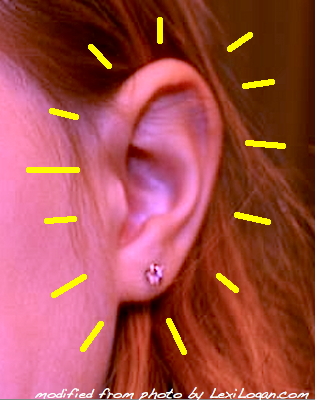Understand and prevent ear infections

We wonder: do elephants get big ear infections?
“An ear infection,” we often hear parents say, “how can that be? I am so careful not to get water into her ear.”
Let us reassure you: parents do not cause ear infections. Germs cause infections. So please: no parent guilt!
When we doctors say “ear infections,” we usually refer to middle ear infections. Where exactly is the middle ear? When we look into the ear we peer down a tunnel called the ear canal. This part of the ear is considered the outer ear. At the end of the tunnel is a sealed door called the “ear drum” The medical term for ear drum is “tympanic membrane.” We’ll stick with “ear drum.” Behind the ear drum is the middle ear. As long as the ear drum (the door) leading into the middle ear is closed, water cannot enter the middle ear. Only if a child has ear tubes, or if the ear drum is ruptured, can water from a pool or bath enter the middle ear.
Now picture yourself opening the door and walking through to the middle ear. When you stand in the middle ear you will see tiny bones which help with hearing. The middle ear is the space that fills with fluid and gives you the uncomfortable sensation of pressure when you have a cold. It is the same space that gives you discomfort when you are descending in an airplane.
In the floor you will see a drain. This drain, called the Eustachian tube, helps drain fluid out of the middle ear. “Popping” your ears by swallowing opens this drain when you are descending on a flight. If fluid (usually from congestion from a cold or from allergies) sits long enough in the middle ear, it can become infected and the resulting pus causes pressure and pain. Sometimes the pressure becomes so great that it causes the ear drum to rupture and the painful infection will then drain out of the ear. Parents are often surprised to learn that this rupturing can occur both in untreated AND treated ear infections.
Beyond the middle ear is the inner ear, which houses nerves needed for hearing. Because children do not tend to get infections here, you may never hear about this part of the ear from your pediatrician (pun absolutely intended).
So, why do people talk about preventing ear infections by preventing water from getting into the ear? There is a type of ear infection called “swimmer’s ear,” formally known as “otitis externa,” which occurs in the outer ear. Swimmer’s ear usually results from a bacteria which grows in a damp environment. The water that causes this damp environment typically comes from a swimming pool, but can also come from lake, ocean, or even bath water. Swimmer’s ear can also be a result of anything that causes ear canal irritation such as eczema, hearing aids, or even beach sand. You can read more about this malady and it’s treatment and prevention here.
To summarize:
Ear infection = middle ear infection
Swimmer’s ear = outer ear infection
Cause of ear infections = germs
So, are you to blame for either type of ear infection? No, but there are associated factors which you can modify.
Wash hands to decrease spread of cold viruses.
Limit exposure to second hand smoke.
Give all vaccines on time – pneumococcal bacteria and the flu virus can cause ear infections–we have vaccines against these germs.
If your child suffers from allergies, talk to your child’s doctor about decreasing triggers in the environment and/or taking medications which might prevent middle ear fluid build-up from allergies.
Some kids who contract a lot of ear infection need help to stop further infections. Ear tubes, or “myringotomy” tubes, promote middle ear fluid drainage before an infection occurs. Ear, nose, throat doctors (also known as ENTs or otolaryngologists) poke a hole in the ear drum leading to the middle ear and place a small tube in the hole. Through the myringotomy tubes, or “ear tubes,” fluid runs from the middle ear out into the outer ear canal before the fluid becomes infected. This drainage prevents middle ear infections from occurring.
To prevent swimmer’s ear, dry your children’s ears with a towel or blow gently with a hairdryer on cool setting after they are done swimming for the day.
We wrote this post because of the many questions we often hear about ear infections and ear anatomy. Hope the information wasn’t too eerie. Or is that EARie?
Naline Lai, MD and Julie Kardos, MD
©2018 Two Peds in a Pod®, updated from 2013
